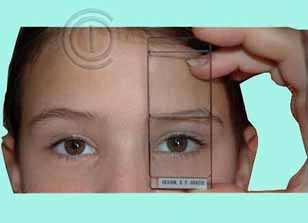6D prisms Base Out - the Gracis biprism appears to be the best actual method of testing eye fixation as early as 6 months; it is the appropriate test for microstrabismus screening - the treatment of the late onset microstrabismus is more simple than the treatment of the early onset microstrabismus, where the dominance of fixation is stronger - if the calibrated filters are sufficient in the first case, the optical penalisation (+ 2 D to + 3 D) on the dominant eye is the best long-term treatment in primary microstrabismus - based on the specific aspects of the early onset strabismus, such as bi-ocularity and latent nystagmus, optical penalization without atropine offers an alternative long-term method to occlusion without any trouble of visual development of the fixating eye.
To detect a total or partial neutralisation of an eye you may use the biprism of Gracis associated with Spielmann's translucent obturator - you place e.g. the Gracis biprism in front of the right eye and you study only motility of the left eye - you can stimulate the right eye by moving down and up an attracting object at a distance of 30 cm in front of it, but you watch only the left eye (L.E.) - 1. lf the L.E. moves vertically down and up, with small saccadic movements in "zig-zag". L.E. is normal. Doubts exists if R.E. neutralises and therefore sends no impulse to L.E. To clear the problem we place a Spielmann translucid obturator before L.E. We see L.E. moving obliquely downwards and nasally to upwards and temporally : when we take away Spielmann's glass lett eye converge, then R.E. is normal as well as L.E.
2. Lf in the first time L.E. moves obliquely from downwards and nasally to upwards and temporally L.E. neutralises.
Afterwards we make the distinction between nasal or temporal neutralisation. Then we try with the Unicorn stem pushed laterally to deneutralise the hemiperipheral retina involved. Superonasal neutralisation may perhaps explain the D.V.D.
Product Weight of the packaged product: 0.05 kg

